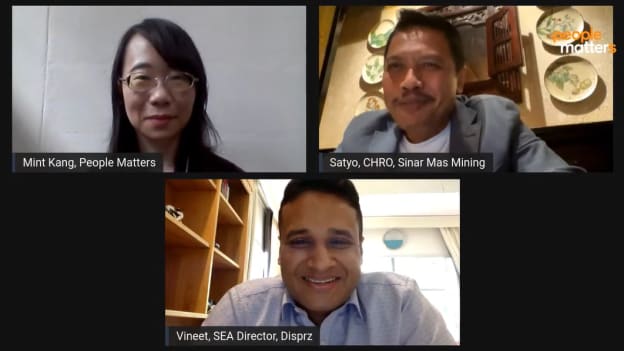Skilling Outlook 2022: Priorities and the Way Forward

Southeast Asia has witnessed tremendous growth in the arena of industrial development and is now a key player in services, trade, communication and manufacturing sectors. Business leaders as a result have realised the importance of employee skill development and are aligning it to the labour market needs in the face of increasing globalisation which brings in a lot of foreign competition and demand. In a webcast hosted by People Matters & Disprz industry leaders Satyo Swasono, CHRO, Sinar Mas Mining and Vineet Koka, SEA Director, Disprz takes a serious look at the past and borrows lessons for the future. Here are some of the key highlights.
Lessons from building skilling programs:
There has been a tremendous shift in the last two years in terms of how companies are looking at their learning and development and skilling programs. There is an understanding that roles are changing and the way a person is supposed to work in this new environment is very different so there is a need for a new set of skills and a new mindset to perform a role effectively. Vineet Koka, SEA Director, Disprz observed that this is the first time that personalized learning has been given a lot of importance. The one-size fits all approach from earlier is being replaced by role based learning and importance is being given to an individual’s learning style.
Satyo Swasono, CHRO, Sinar Mas Mining noted that HR practices changed in three major areas: workplace, workforce and the working environment. In Sinar Mas, there was a categorisation of the levels of change. The first is leading through change - developing the employees with change. Second is diversity and inclusion which has become a priority in talent development. Third is large-scale re-skilling and upskilling. Fourth is digital transformation. The last is learning with a spiritual lens - acknowledging that the world has become even smaller and geographical barriers have been removed with more room for connecting with people.
A lot of the companies have quickly evolved under the L&D teams' understanding of how the environment is changing and how they need to support their employees. Classroom models of learning from earlier are being replaced by blended formats with a mix of e-learning modules, webinars and classroom training.
This is the first step to making learning mobile. Now learning is being incorporated into the flow of work as a continuous process.
Challenges in upskilling employees:
There is a need to check if the skills are directly impacting the performance. Under Sinar Mas, some companies have mandatory upskilling where renewal of certificates and training requirements is scheduled very tight since there is a direct impact on the business. The focus is on ensuring that all the requirements for certification are connected to the job itself. Team leaders also need to ensure that employees can complete and renew the certification according to their convenience and not interrupt their business operations. AI and machine learning is helping the employees to focus only on what is relevant for them and not get carried away with the huge sea of knowledge that might be interesting but are not helpful for their immediate needs. Apart from the mandatory requirements, the new innovations in the industry such as digitisation, robotic automation will need to be incorporated into the workforce so the employees will not be left behind and they can stay relevant.
Key learning trends that will impact the job market in South East Asia:
In Southeast Asia despite the pandemic situation, the job market is still positive with 75% of the employers still hiring. There is a lot of growth in the startup ecosystem and there are conglomerates who aspire to grow to global standards. This means they want to have the best talent hired and trained.
A few things have been observed in the job market trends. The recruitment platform and the process itself is becoming virtual and automated. So there is a rising need to have a close fit of skills with the job role to identify the skills that the person needs and how they can be trained. This also ensures that they are able to perform after they are onboarded.
Companies are also focusing on cross-skilling - managing talent requirements not by looking externally but rather internally by cross-skilling employees. Employees are provided with more skills which were not needed for their role immediately, but doing so enables them to take higher responsibilities. Talent mobility has become a very important thing in terms of making the talent mobile within the organization to help the growth of employees to the next level.
Driving better outcomes and increasing organisational performance:
In Sinar Mas, the job matrix pillar is based on cross matrix learning and employees can access everything they require through a learning platform. LXP is used for mandatory requirement or regulatory compliance for any certification to facilitate learning anywhere, anytime for employees. In order to increase employee engagement immersive learning processes like video, animation and games have been implemented. Gamification of the learning process is a key contributor for the success of the learning process. The impact of the learning process to the performance of the employee is also monitored with the help of dashboards connected to the performance management system. In this way leaders can plan the next directions and take appropriate precautions to maximize the results.
Vineet observed that a lot of companies have also taken the approach of building functional academies. Earlier companies used to focus on leadership training like leadership academy, building mid-level managers but now companies have realized the value of having functional academies. These come in the form of formal end-to-end training programs or academies. In these academies, there is a defined journey on how an employee can build particular skills to be efficient at their job role. Here a lot of AI and machine learning is being used to provide employees with the best relevant content available so that they can correlate with what is happening at an industry level worldwide.
Key focus areas have emerged with the skilling curve. The first is the requirement of a hands-on and modern system which is well equipped with UI and UX to replace the old legacy systems.
Second is the need to dive deep into a sub-industry level. L&D teams have now understood that there is a need to take a sub industry approach in order to understand the roles and marketplace skills needed to perform a role effectively. After that they review the content available to develop those skills. Sometimes that content is not available in any catalog so they design and deliver the content so that an individual or an employee can develop those skills.
Performance indicators to assess and measure the impact of skilling programs:
Awareness of the skill gap is the top priority to building skilling programs. Following this the second stepis skill development. Performance enhancement is not possible without skill development. Skill development can take place through strategies designed to identify hidden potential among the employees. For this, the HR system must have a meticulous system profiling the employees in the organization.
Learning and performance are intricately intertwined. A lot of learning platforms now have integrated performance management systems. Every skill can be broken down into levels and the progression of skill levels can be linked to the performance on ground relevant to that specific skill. This can be measured in many ways like manager feedback, 360 degree feedback, job assignments,etc. These platforms that connect learning and performance directly show the ROI of skilling to the companies.
The important thing that a lot of organizations need to do is skilling their existing L&D teams in order to implement the targeted initiatives. Just having the skilling platform or tools will not help until unless the custodians themselves are trained and equipped with the roadmap to succeed.






